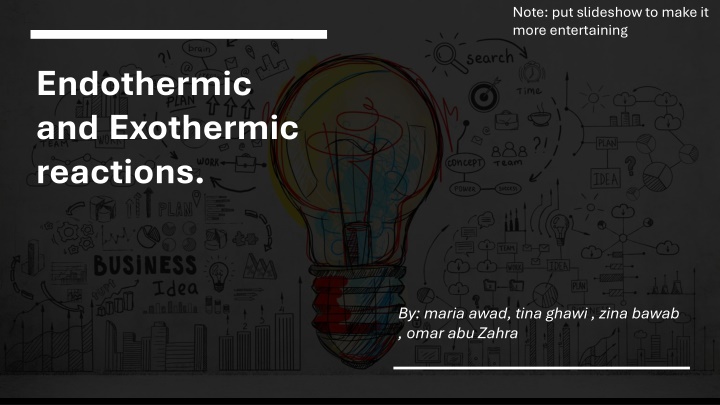
Endothermic and Exothermic Reactions in Chemistry
Explore the concepts of endothermic and exothermic reactions in chemistry with examples such as photosynthesis and combustion. Learn how these reactions absorb or release energy from the surroundings, affecting temperature and creating distinct effects. Dive into the world of chemical reactions and their role in our everyday lives.
Download Presentation

Please find below an Image/Link to download the presentation.
The content on the website is provided AS IS for your information and personal use only. It may not be sold, licensed, or shared on other websites without obtaining consent from the author. If you encounter any issues during the download, it is possible that the publisher has removed the file from their server.
You are allowed to download the files provided on this website for personal or commercial use, subject to the condition that they are used lawfully. All files are the property of their respective owners.
The content on the website is provided AS IS for your information and personal use only. It may not be sold, licensed, or shared on other websites without obtaining consent from the author.
E N D
Presentation Transcript
Note: put slideshow to make it more entertaining Endothermic and Exothermic reactions. By: maria awad, tina ghawi , zina bawab , omar abu Zahra
Endothermic and Exothermic reactions are: Endothermic reactions are: Exothermic reactions are: Endothermic reactions are chemical reactions in which the reactants absorb heat energy from the surroundings to form products. These reactions lower the temperature of their surrounding area, thereby creating a cooling effect. Exothermic reactions These are reactions that transfer energy to the surroundings. The energy is usually transferred as heat energy, causing the reaction mixture and its surroundings to become hotter. A thermometer is used to detect the temperature increase.
Photosynthesis An example of a endothermic reaction is: Photosynthesis is when a plant absorbs energy from the sun and convert it into carbon dioxide and water into glucose and oxygen. and a lab test example: https://youtu.be/GfPJsHM6dsQ
Combustion An example of a exothermic reaction is: Combustion is the scientific word for burning. An reaction is one where a substance reacts with oxygen and produces oxides. An oxide is a chemical compound that contains at least one oxygen atom and one other element in its chemical formula. Combustion is an example of an oxidation reaction. Many fuels contain carbon and hydrogen atoms. And a lab test example: https://youtu.be/UMEbeyKrE30
Thank you for listening/reading.
